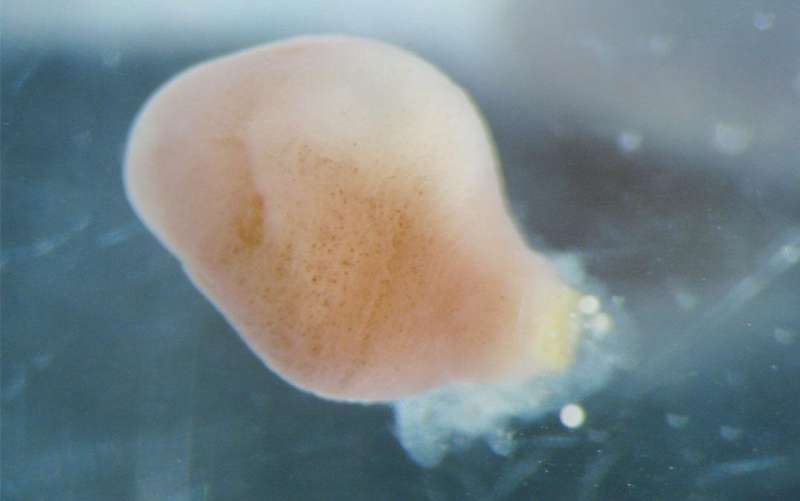Researchers led by the University of Tsukuba discover a unique reproductive strategy in deep-sea worm-like creatures that could help solve a long-standing puzzle. Credit: University of Tsukuba
Deep on the ocean floor, strange worm-like creatures can be found, the evolution of which has long perplexed scientists. Now, in a recently published study, researchers from Japan have observed an interesting mode of reproduction, which could shed light on the life history of these species.
In the recent study, researchers led by the University of Tsukuba reported that Xenoturbella bocki releases gametes (reproductive cells) through ruptures in its body wall. The findings are published in the journal Communications Biology.
Until recently, little was known about Xenoturbella, a genus of simple marine animals that live on muddy sea bottoms. The six species of Xenoturbella identified to date live deep in the ocean, generally below 200 m. An interesting feature of all of these species is the simplicity of their body plan; they have mouths but no eyes, brains, stomachs, or anuses. They also have bilateral symmetry, meaning the right and left sides are, more or less, symmetrical. This body plan has led to confusion about where exactly these creatures fit in the tree of life.
"The phylogenetic position (evolutionary history) of these species is still unclear," says lead author of the study, Associate Professor Hiroaki Nakano. "Because the development of a species can often provide clues to how that species evolved, we wanted to investigate the reproduction and development of these species in the lab."
The challenge the researchers faced is keeping adult Xenoturbella alive in a laboratory setting. Xenoturbella bocki inhabit shallower waters than the other species belonging to this genus, which makes them slightly more robust; so, the researchers were able to keep adult worms alive.
Adult Xenoturbella were collected from the Gullmarsfjord, Sweden, and back in the laboratory, they were induced to spawn once a month. These experiments not only showed that the breeding season for this species is winter, but also revealed an interesting mode of reproduction.
"When the animals spawned, we noticed that the eggs and sperm were released from new openings in the body wall. These openings appeared to be ruptures in the body that only appeared for spawning," explains Associate Professor Nakano. "Based on our observations, we think that gametes likely begin to mature on the surface of the gut, are released into the body cavity when mature, and are then released into the water through these ruptures."
Understanding the reproductive features of Xenoturbella will ultimately help clarify the phylogeny of these unusual marine worms. Successful reproduction in the laboratory provides the basis for studying larval development and, hopefully, will help uncover additional clues to this evolutionary mystery.
More information: Hiroaki Nakano et al, Induced spawning with gamete release from body ruptures during reproduction of Xenoturbella bocki, Communications Biology (2023). DOI: 10.1038/s42003-023-04549-z
Journal information: Communications Biology
Provided by University of Tsukuba
























